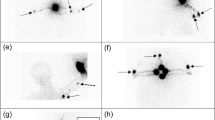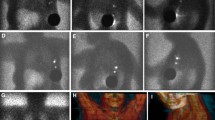Abstract
Background
Several 99mTc-labeled agents that are not approved by the U.S. Food and Drug Administration are used for lymphatic mapping. A new low-molecular-weight mannose receptor–based, reticuloendothelial cell-directed, 99mTc-labeled lymphatic imaging agent, 99mTc-tilmanocept, was used for lymphatic mapping of sentinel lymph nodes (SLNs) from patients with primary breast cancer or melanoma malignancies. This novel molecular species provides the basis for potentially enhanced SLN mapping reliability.
Methods
In a prospectively planned, open-label phase 2 clinical study, 99mTc-tilmanocept was injected into breast cancer and cutaneous melanoma patients before intraoperative lymphatic mapping. Injection technique, preoperative lymphoscintigraphy (LS), and intraoperative lymphatic mapping with a handheld gamma detection probe were performed by investigators per standard practice.
Results
Seventy-eight patients underwent 99mTc-tilmanocept injection and were evaluated (47 melanoma, 31 breast cancer). For those whom LS was performed (55 patients, 70.5%), a 99mTc-tilmanocept hot spot was identified in 94.5% of LS patients before surgery. Intraoperatively, 99mTc-tilmanocept identified at least one regional SLN in 75 (96.2%) of 78 patients: 46 (97.9%) of 47 in melanoma and 29 (93.5%) of 31 in breast cancer cases. Tissue specificity of 99mTc-tilmanocept for lymph nodes was 100%, displaying 95.1% mapping sensitivity by localizing in 173 of 182 nodes removed during surgery. The overall proportion of 99mTc-tilmanocept-identified nodes that contained metastatic disease was 13.7%. Five procedure-related serious adverse events occurred, none related to 99mTc-tilmanocept.
Conclusions
Our results demonstrate the safety and efficacy of 99mTc-tilmanocept for use in intraoperative lymphatic mapping. The high intraoperative localization and lymph node specificity of 99mTc-tilmanocept and the identification of metastatic disease within the nodes suggest SLNs are effectively identified by this novel mannose receptor–targeted molecule.


Similar content being viewed by others
References
Leong SP, Donegan E, Heffernon W, Dean S, Katz JA. Adverse reactions to isosulfan blue during selective sentinel lymph node dissection in melanoma. Ann Surg Oncol. 2000;7:361–6.
Komenaka IK, Bauer VP, Schnabel FR, et al. Allergic reactions to isosulfan blue in sentinel lymph node mapping. Breast J. 2005;11:70–2.
King TA, Fey JV, Van Zee KJ, et al. A prospective analysis of the effect of blue-dye volume on sentinel lymph node mapping success and incidence of allergic reaction in patients with breast cancer. Ann Surg Oncol. 2004;11:535–41.
Scherer K, Studer W, Figueiredo V, Bircher AJ. Anaphylaxis to isosulfan blue and cross-reactivity to patent blue v: case report and review of the nomenclature of vital blue dyes. Ann Allergy Asthma Immunol. 2006;96:497–500.
Efron P, Knudsen E, Hirshorn S, Copeland EM. Anaphylactic reaction to isosulfan blue used for sentinel node biopsy: case report and literature review. Breast J. 2002;8:396–99.
Cimmino VM, Brown AC, Szocik JF, et al. Allergic reactions to isosulfan blue during sentinel node biopsy—a common event. Surgery. 2001;130:439–42.
Mariani G, Gipponi M, Moresco L, et al. Radioguided sentinel lymph node biopsy in malignant cutaneous melanoma. J Nucl Med. 2002;43:811–27.
Krynyckyi BR, Kim CK, Goyenechea MR, et al. Clinical breast lymphoscintigraphy: optimal techniques for performing studies, image atlas, and analysis of images. Radiographics. 2004;24:121–39.
Stojadinovic A, Peoples GE, Jurgens JS, et al. Standard versus pH-adjusted and lidocaine supplemented radiocolloid for patients undergoing sentinel-lymph-node mapping and biopsy for early breast cancer (PASSION-P Trial): a double-blind, randomised controlled trial. Lancet Oncol. 2009;10:849–54.
Vera DR, Wallace AM, Hoh CK, Mattrey RF. A synthetic macromolecule for sentinel node detection: 99mTc-DTPA-mannosyl-dextran. J Nucl Med. 2001;42:951–9.
Hoh CK, Wallace AM, Vera DR. Preclinical studies of [(99m)Tc]DTPA-mannosyl-dextran. Nucl Med Biol. 2003;30:457–64.
Ellner SJ, Hoh CK, Vera DR, et al. Dose-dependent biodistribution of [(99m)Tc]DTPA-mannosyl-dextran for breast cancer sentinel lymph node mapping. Nucl Med Biol. 2003;30:805–10.
Wallace AM, Hoh CK, Vera DR, et al. Lymphoseek: a molecular radiopharmaceutical for sentinel node detection. Ann Surg Oncol. 2003;10:531–8.
Wallace AM, Hoh CK, Darrah DD, et al. Sentinel lymph node mapping of breast cancer via intradermal administration of Lymphoseek. Nucl Med Biol. 2007;34:849–53.
Wallace AM, Hoh CK, Limmer KK, et al. Sentinel lymph node accumulation of Lymphoseek and Tc-99m-sulfur colloid using a “2-day” protocol. Nucl Med Biol. 2009;36:687–92.
Wallace AM, Hoh CK, Ellner, SJ, et al. Lymphoseek: a molecular imaging agent for melanoma sentinel lymph node mapping. Ann Surg Oncol. 2007;14:913–21.
Pukelsheim F. The three sigma rule. Am Stat. 1994;48:88–91.
Cipra T, Fuchs A, Formánek J, et al. Detection and interpolation of outliers in biosignals. Act Nerv Super (Praha). 1990;32:283–91.
Smirnov NV, Dunin-Barkovskii IV. Mathematische Statistik in der Technik. Verlag Wissenschaft; 1969.
Krag DN, Anderson SJ, Julian TB, et al. Technical outcomes of sentinel-lymph-node resection and conventional axillary-lymph-node dissection in patients with clinically node-negative breast cancer: results from the NSABP B-32 randomised phase III trial. Lancet Oncol. 2007;8:881–8.
Weaver DL, Le UP, Dupuis SL, et al. Metastasis detection in sentinel lymph nodes: comparison of a limited widely spaced (NSABP protocol B-32) and a comprehensive narrowly spaced paraffin block sectioning strategy. Am J Surg Pathol. 2009;33:1583–9.
Morton DL, Thompson JF, Cochran AJ, et al. Sentinel-node biopsy or nodal observation in melanoma. N Engl J Med. 2006;355:1307–17.
Méndez J, Wallace AM, Hoh CK, Vera DR. Detection of gastric and colonic sentinel nodes through endoscopic administration of 99mTc-DTPA-mannosyl-dextran in pigs. J Nucl Med. 2003;44:1677–81.
Wallace AM, Ellner SJ, Mendez J, et al. Minimally invasive sentinel lymph node mapping of the pig colon with Lymphoseek. Surgery. 2006;139:217–23.
Ellner SJ, Mendez J, Vera DR, et al. Sentinel lymph node mapping of the colon and stomach using Lymphoseek in a pig model. Ann Surg Oncol. 2004;11:674–81.
Salem CE, Hoh CK, Wallace AM, Vera DR. A preclinical study of prostate sentinel lymph node mapping with [99mTc]diethylenetriamine pentaacetic acid-mannosyl-dextran. J Urol. 2006;175:744–8.
American Cancer Society. Cancer Facts and Figures 2010. Atlanta: American Cancer Society; 2010.
Ferlay J, Parkin DM, Steliarova-Foucher E. Estimates of cancer incidence and mortality in Europe in 2008. Eur J Cancer. 2010;46:765–81.
Ferlay J, Shin HR, Bray F, et al. Estimates of worldwide burden of cancer in 2008: GLOBOCAN 2008. Int J Cancer. 2010;127:2893–917.
Limmer KK, Povoski SP, Krontiras H, et al. Phase III trial results comparing Lymphoseek with blue dye in detection of the sentinel lymph node in breast cancer (abstract 304). Cancer Res. 2009;69(Suppl 24):514s.
Sondak VK, Marzban S, Rich CJ, et al. Identification of melanoma sentinel nodes with Lymphoseek: phase III clinical trial results at Moffitt Cancer Center (abstract P250). Ann Surg Oncol. 2010;17(Suppl 1):S111.
Kim J, Ross M, Faries M, et al. A phase 2, single arm, open-label, multicenter study to evaluate the safety and efficacy of Lymphoseek as a lymphoid tissue targeting agent in patients with known or suspected melanoma or breast cancer who are undergoing lymph node mapping (abstract P105). Ann Surg Oncol. 2008;15(Suppl 2):65.
Acknowledgment
The authors acknowledge Statking Consulting Inc. (Fairfield, OH) for support in statistical analysis. This work was partially supported by the National Institutes of Health grant K23 CA109115-01A3 (to JK). The authors declare financial interest and/or investment in the sponsoring company, Neoprobe Corporation.
Conflicts of Interest
None.
Author information
Authors and Affiliations
Corresponding author
Rights and permissions
About this article
Cite this article
Leong, S.P.L., Kim, J., Ross, M. et al. A Phase 2 Study of 99mTc-Tilmanocept in the Detection of Sentinel Lymph Nodes in Melanoma and Breast Cancer. Ann Surg Oncol 18, 961–969 (2011). https://doi.org/10.1245/s10434-010-1524-z
Received:
Published:
Issue Date:
DOI: https://doi.org/10.1245/s10434-010-1524-z




